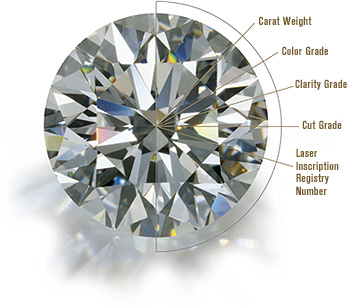The four areas to consider are cut, clarity, color, and carat weight, commonly referred to as the 4 c’s of diamond buying.
Cut
The cut refers to a diamond’s reflective quality, which should not be confused with its shape. The cut is probably the most important of the c’s because it gives the diamond its brilliance. And this is the only aspect of the diamond’s quality that man has a hand in. Diamonds taken from the earth usually look like a piece of glass and must be cut with precise facets. The facets, or tiny faces, need to be cut with expert precision. If the diamond isn’t cut and proportioned properly, light will not reflect well off the gem, giving it a dull appearance. Even a diamond with amazing color and clarity will not look good if it’s cut poorly. When a diamond is cut in the proper proportions light reflects from one facet to another and is dispersed throughout the top of the gem. The standards developed to grade the cut begin with poor and fair, progressing to good, very good, and premium. The highest standard is ideal.
Clarity
Clarity refers to how clear the diamond is, which is an indication of its purity is. This also includes any identifying characteristics of the diamond, which are specified as inclusions or blemishes. Diamonds with fewer inclusions are rarer and exude a greater brilliance. The grades of clarity include F – flawless, IF – internally flawless, VVS1 – VVS2 – very, very slightly included, VS1 – VS2 – very slightly included, and SI1 – SI2 – slightly included.
Color
Colorless diamonds are more desirable since they allow more light to pass through. Some diamonds may appear colorless when looked at individually, but might have subtle brown or yellow coloring when held against a truly colorless diamond. Color becomes more difficult to detect after a stone has been set. A stone will appear clearer and more brilliant when set against a darker background. Color in a diamond means it has been exposed to chemicals other than carbon. Diamonds are rated on a GIA diamond color chart using a letter system. Diamonds rated D, E, or F or considered colorless. Diamonds G through J are near colorless, while K through M are labeled as faint color. Finally, N through Z are in the ranges of very light color and light color. Some diamonds, however, are naturally formed with color. Defined pink, red, blue, and green diamonds are actually quite rare.
Carat Weight
This is the unit of measurement used to weigh the diamond, and is not related to its actually size. Although most larger diamonds have more carats, this is not always the case. A diamond may be cut in such a way that it might appear to have a larger surface than another diamond, but the two may actually be the same carat weight. One carat weighs 200 milligrams, or 0.2 grams. After rough diamonds are cut they can lose over half of a carat in the process.
Perhaps most important of all is where you purchase the diamond. Make sure that you visit a well-renowned expert. There are many things to consider when purchasing diamonds. A larger diamond isn’t necessarily more valuable, therefore a buyer must decide if she’s looking for size, brilliance, or both.
